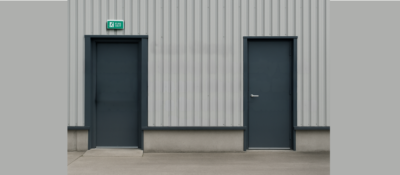Fire doors are a vital part of a building’s fire safety strategy and an essential component of fire protection. They serve as protective barriers, preventing fires from spreading and providing time for evacuation. They are crucial in containing fire within one part of the building - limiting damage - and protecting escape routes. These doors are not like regular doors; they are made from fire-resistant materials and are designed to withstand fire for 30 minutes or more. And, to ensure proper installation and compliance, a fire doors form must be completed by a certified professional upon fitting.
A unique aspect of fire doors is their design to automatically close in the event of a fire. This automatic closure contains the fire and toxic smoke, preventing them from spreading and causing further damage. Some fire doors are even equipped with automatic systems that connect to the building’s fire alarm system, providing enhanced protection against the spread of fire and facilitating safe evacuation.
The effectiveness of a fire door, however, heavily depends on its fire resistance rating and the components it comprises. So, what exactly are fire resistance ratings, and what components make up a fire door?
Fire resistance ratings, such as FD30 and FD60, denote the duration, in minutes, that a fire door can resist fire and smoke before it fails. These ratings play a crucial role in determining the suitability of a fire door for a specific location within a building. But how can we be sure that these ratings are accurate and reliable?
Third-party certification for fire doors, awarded by institutions like the BSI, confirms compliance with fire resistance standards BS 476 and BS EN 1634. This certification is essential for validating the effectiveness of fire doors. Fire doors are available with varied levels of fire resistance, demonstrated by colours on fire door plugs, with common certifications offering 30 minutes (yellow), 60 minutes (blue), and higher-end protection up to 120 minutes.
The fire resistance performance of doors is also influenced by components such as insulated glass units that block heat, as well as smoke seals that prevent smoke infiltration – a primary cause of harm during a fire event.
A fire door is more than just a door; it comprises various components, each serving a critical purpose. One such component is the intumescent seal. These seals are designed to expand at temperatures above 200°C, sealing gaps between the fire door and frame, and are rated for 30 or 60 minutes of fire resistance. These seals play a crucial role in preventing smoke and flames from spreading.
Another critical component of a fire door is the certified fire door frame. A fire door frame must be certified to guarantee that it contributes effectively to the fire safety performance of the door. In addition, fire doors are fitted with self-closing mechanisms, typically metal arms above the door, ensuring they automatically close to maintain an effective seal against fire and smoke spread.
To be compliant, a fire door must also:
Lastly, the gaps around the top and sides of a closed fire door should be less than 4mm to effectively prevent smoke or fire from passing through.
Fire doors are a legal requirement across various types of buildings, including all non-domestic properties, blocks of flats, and houses of multiple occupancy, to ensure safe escape routes. But where exactly should these fire doors be installed?
In commercial buildings with more than one floor, fire doors must secure both vertical and horizontal escape routes. The Regulatory Reform (Fire Safety) Order 2005 demands appropriate fire safety measures, such as fire doors, in the common areas of blocks of flats for safe egress. Additionally, in mixed-use buildings, fire doors are required between residential and commercial spaces to maintain separation and safety.
Fire doors must also be installed in the following areas:
Ultimately, internal fire doors are mandatory in all doorways leading to and comprising part of escape routes to enhance occupant safety during fire incidents.
In residential buildings and flats, there are specific requirements for fire doors. FD30 fire doors, providing at least 30 minutes of fire resistance, are typically required in domestic dwellings that are three or more storeys high. In buildings with three or more stories, fire doors are mandatory in every entryway from a stairwell to habitable rooms, as well as between a house and an integral garage.
For ground floor flats, FD30 fire doors should be installed as front doors to each flat and between habitable rooms and corridors to ensure compartmentalisation and safe escape routes. In mixed-use buildings with residential and commercial areas, regulations require fire doors to be installed in any doorways that connect the two different types of spaces, including those leading to a habitable room.

On the commercial front, fire doors are required in all properties used for non-domestic purposes, and their implementation details are specified in the Building Regulations Approved Documents. For instance, in retail spaces like shops and restaurants, fire doors are mandated for the commercial area itself as well as the main entrance to any residential areas above the commercial space. Industrial buildings must incorporate fire doors on all escape route exits.
In public buildings, fire doors are integral to sub-dividing corridors, stairways, lobbies, and areas like plant rooms, ensuring safe vertical and horizontal escape routes. The requirement for fire doors in such properties is reinforced by the Building Regulations across the UK and the Fire Safety (England) Regulations 2022, emphasising compliance and safety.
Property owners are legally required to ensure their premises comply with fire safety standards, which include the provision of fire doors, particularly in non-domestic properties, communal areas of residential buildings, and places of employment. Fire doors are essential for compartmentalisation, helping to contain fires within one part of the building and fire doors are required in doorways that lead to escape routes and rooms at higher risk of fire.
The Regularity Reform (Fire Safety) Order 2005 mandates ongoing maintenance and efficient working order of fire doors in existing buildings. The Fire Safety Act 2021 emphasises the importance of including flat entrance doors within the Fire Risk Assessment, a responsibility under the Fire Safety Order. Non-compliance with these regulations can lead to significant legal consequences, including hefty fines and potential imprisonment.
Complying with fire door regulations by referencing fire risk assessments to confirm whether doors meet current standards is paramount for the safety of occupants and the building. But how does one ensure compliance? The answer lies in regular fire door inspections and maintenance.
The Regulatory Reform (Fire Safety) Order 2005 governs commercial premises, including those that are part of domestic dwellings, charity workspaces, public buildings, places of employment, entertainment, leisure, and a range of accommodations, but excludes individual private homes. Under this order, the designated ‘Responsible Person’ is legally obligated to ensure that:
A suitable and sufficient fire risk assessment must be carried out for buildings to comply with the Regulatory Reform (Fire Safety) Order 2005, and should be performed without delay if one is not already in place. In residential buildings with more than two dwellings, the Responsible Person must provide residents with information concerning the importance of maintaining fire doors as part of their safety responsibilities.
Building regulations and fire risk assessments are integral to determining the adequacy of fire-resisting doors (fire doors) to safeguard means of escape from fire. The fire risk assessment is responsible for determining the specific commercial fire doors requirement within a building. For residential buildings with multiple dwellings, the Responsible Person must conduct a fire risk assessment and inform residents about the importance of fire doors.
Building regulations specify the need for legitimate fire doors and provide standards for new buildings and conversions, such as the FD30 doors standard for flat entrance doors. With fire doors fitted, the fire safety regulations outline the inspection frequencies for fire doors in buildings with common parts and set the legal framework for fire safety in flats.
It’s worth noting that houses and bungalows normally do not require fire doors unless they are new builds, have three or more floors, or have doors leading into an integral garage. To ensure the safety of the public, fire door regulations are subject to changes and updates based on the latest safety standards and evidence.
Maintaining fire doors and ensuring their efficient working order is a necessary aspect of fire safety. Regular fire door inspections should occur at least once every six months, potentially conducted by a Fire Door Inspection Scheme accredited professional.
Electromagnetic fire door holders or similar devices can keep fire doors open, but they are required to automatically close them at the sound of the fire alarm. This feature is particularly useful in high-traffic areas where doors need to remain open for convenience but must close during a fire to prevent the spread of flames and smoke.
To fulfil legal requirements, fire doors must be primarily tested doors that have undergone full-set testing in a laboratory setting, not just doors with labels. This ensures that these doors can withstand the heat and pressure of a real fire, providing a safe and effective barrier.
Fire doors must conform to standards such as BS 476-22:1987 or BS EN1634-1:2014 in new or repurposed buildings according to Building Regulations Approved Documents in England and Wales. The Q-Mark Fire Door Scheme from BM TRADA certifies that fire doors meet necessary standards for smoke control and fire resistance. Under this scheme, a licensed supervisor is responsible for signing off on installation work, underpinning the integrity of the certification process.
Fire door suppliers must provide precise installation instructions that need to be followed meticulously to ensure proper function.
There is no formal qualification requirement to install fire doors; however, those who do so must be competent and skilled. Achieving a certificate, such as the one assured by the Royal Society for the Prevention of Accidents (RoSPA), should be considered evidence of the competence and skill required to install fire doors.
A fire door’s performance in a fire event heavily relies on the use of certified fire door frames; standard frames are not suitable substitutes. Fire doors require at least three hinges with a melting point above 800 degrees Celsius, ensuring they remain operative and attached during a fire.
Additionally, specialist intervention is necessary for retrofitting fire door vision panels to guarantee they do not compromise the door’s integrity and abide by safety standards.
Smart fire doors are equipped with automated systems to enhance fire safety management. Electromagnetic devices, also known as hold-open devices, can be installed on fire doors to keep them open in high-traffic areas but will automatically close the fire door when a fire alarm is triggered.
Swing automatic fire doors are available with battery backups that allow them to be pulled or pushed open in emergencies or opened upon fire alarm activation. These innovative features enhance fire safety management and ensure that fire doors perform their vital role efficiently and effectively during a fire event.
In conclusion, fire doors play a pivotal role in building safety, containing fires, limiting damage, and protecting escape routes. They are designed to withstand fire for a significant duration, with fire resistance ratings denoting their capacity to resist fire and smoke. Fire doors comprise various components, all of which are vital to their function and effectiveness. Hopefully, this blog post gives you more ideas about where you should locate fire doors on your premises.
Take a look at our variety of high quality steel fire doors at Security Direct today.

Discover how Security Direct supplied and installed a full suite of steel doors and steel fire exit ...

Discover the differences between steel doors, metal fire doors, fire exit doors, and external securi...

A growing technology firm approached Security Direct after expanding into a new open-plan office spa...